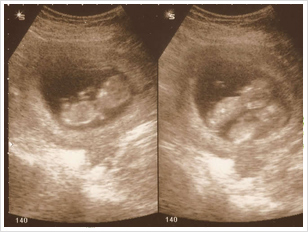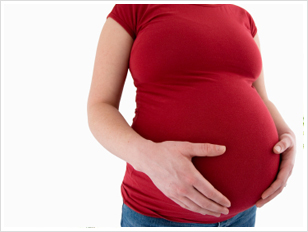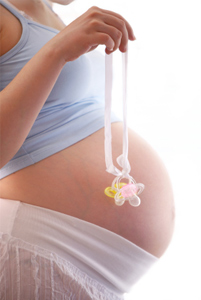Because a lot of the developments are similar for singleton and multiple pregnancies, moms expecting twins can still relate to most of the changes we have described in our week by week guide. However a few things are different, which is why in this article we will tackle the three twin pregnancy trimesters one by one – taking a closer look at those few changes that sets a multiple pregnancy apart from a singleton pregnancy.
Remember that this is simply a guide to typical changes, symptoms and developments that take place in a twin pregnancy week by week, and that each pregnancy vary from woman to woman. So don’t be alarmed if you are not following this guide perfectly. Should you be concerned about anything at all, however, don’t hesitate to contact your practitioner for advice and peace of mind.
Before we take a look at your twin pregnancy trimesters, let’s explain briefly how the conception of twins take place. When you ovulate two eggs that are fertilised by two different sperm, you’ll have fraternal twins. When you ovulate one egg that is fertilised by one sperm but then spontaneously split in half afterwards, you’ll have identical twins. While having fraternal twins is often hereditary, having identical twins can happen to anyone. So this confirms the fact that just because there are no twins in your family, that doesn’t mean you won’t have twins!
Your First Twin Pregnancy Trimester
Pregnancy is measured in trimesters from the first day of your last menstrual period, totalling 40 weeks for singleton pregnancies and 38 weeks for multiple pregnancies. The first trimester of a pregnancy is week 1 through to week 12; about three months.
Throughout the first few weeks it’s very unlikely that you know you are carrying twins. Only when you have your first ultrasound you’ll be able to enjoy the somewhat scary but truly wonderful news. However some twin-moms-to-be report that they experience heightened pregnancy symptoms such as extreme morning sickness (nausea and vomiting), breast tenderness and fatigue. But others don’t experience these symptoms at all. So there’s no way to tell, really, until that first ultrasound takes place. Twins are usually visible via ultrasound as early as week 6.
When pregnant with twins your practitioner might ask you to see him more frequently so that he can monitor your pregnancy closely and keep an eye out for signs of preterm labour. He’ll also tell you that you need to be taking more folic acid, calcium, iron and protein. And he may ask you to limit some activities – such as work, exercise and travelling – in order to get more rest.
During the first week after fertilisation, the fertilised egg(s) grow into a microscopic ball of cells called a blastocyst. The blastocyst implants on the wall of your uterus- which in turn triggers a whole lot of both physical and hormonal changes in your body.
From week 3 to week 8 the embryos develop most body organs and are vulnerable to damaging substances such as alcohol, cigarettes, radiation and infectious diseases – which is why you should always follow a healthy and sensible lifestyle when you are trying for a baby or suspect that you might be pregnant.
By week 8 or 9 the embryos reach a size of about 3cm in length and from now on, in their last month representing the embryonic stage, they progress rapidly.
By week 12 all your miracles’ little organs and structures are perfectly formed, and the chances of having a miscarriage have now dropped a great deal. By the end of twelve weeks your babies have grown to a length of approximately 5cm and weigh about 140g each.
Click here to read about your Second Twin Pregnancy Trimester
]]>Great news for you is that typical pregnancy side-effects will decrease in the beginning of your second trimester, which means this will be a much more enjoyable time for you. You will however start showing sooner than women going through a singleton pregnancy, as your uterus is expanding drastically daily in order to accommodate two growing babies.
Weeks 12-16 see your babies’ kidneys starting to function, and towards week 16 water in their stomachs and urine in their bladders may be detected via ultrasound. There’s by now lots of movement happening, but it’s unlikely that you will start feeling it just yet.
By the end of week 20 your two bundles of joy will be fully formed and it’s believed that they are now aware of each other. You will more likely than not feel tiny fluttering movements and kicks and will definitely start to look very pregnant. Apart from experiencing constipation you should be feeling much better and have increased energy.
In your second trimester you should also be able to determine your babies’ sex during a scan. And towards the middle of the trimester they develop hearing, so you can start talking to them and playing music for them.
By the end of week 24 your twins will measure around 30cm each and weigh around 5-600g each – continuously fighting for position and moving around. Typically lying in the foetal position, your twins are now covered in downy hair (lanugo) and a cheesy coating (vernix) to protect their delicate skin.
The last month of your second trimester will see both your twins grow even more rapidly. In fact, they will just about double in weight! Because of the incredible advances in care for premature infants, by the end of week 28 your twins’ rate of survival is very strong. Their lungs are now developing and they start practising breathing. Unique fingerprints have formed and your babies should be able to grimace and squint by now.
With your uterus growing and stretching you’ll unfortunately see many side-effects of pregnancy return towards the end of your second trimester – such as frequent urination, swollen feet, fatigue, haemorrhoids and ligament pain.
Click here to read about your Third Twin Pregnancy Trimester
]]>For you discomfort in many ways – such as back pain, shortness of breath, fatigue, sleepless nights and heartburn (as your stomach struggles for the appropriate digestive space) – will increase. Listen to your body and rest as much as possible! You know how hectic it will be as soon as your bundles of joy are born, so getting both physical and mental rest is very important.
During weeks 28-32 the size of your babies’ bodies is catching up in relation to the size of their head – which might have seemed disproportionately larger before. On average, the twins’ growth will begin to slow around 30-32 weeks, while a singleton baby’s growth continues until delivery.
In weeks 32-36 your twins will also have fully grown fingernails and toenails. And they are still getting lots of nourishment from the placenta in order to help them gain that significant final layer of fat.
For you there may be an increase in Braxton-Hicks contractions by now. Call your practitioner if they are painful or persistent, as it could be a sign of preterm labour. Other signs of preterm labour could be a feeling of fullness or pressure in the pelvis, change or increase in vaginal discharge, spotting or bleeding, leaking amniotic fluid and effacement and dilation.
By your twins’ position in your womb your practitioner should now be able to tell you whether you can have a natural birth or will need to have a Caesarian.
Towards the end of your twin pregnancy you’ll find there’s less movement as there is simply not enough space for two babies to move freely. So don’t worry if you are not able to feel your babies shift around as often as they used to.
Full term for a twin pregnancy is 38 weeks, unlike the 40 weeks for a singleton pregnancy. However the majority of twins are born by the end of week 36. So be prepared, have your hospital bag packed and get as much rest as possible in your third trimester – you know you’ll need it!
References:
www.webmd.com
www.twin-pregnancy-and-beyond.com
High blood pressure and anaemia
High blood pressure and anaemia are both common twin pregnancy complications that mom might have to deal with. When high blood pressure is combined with protein in the urine, the condition is known as preeclampsia and careful monitoring is needed to prevent serious problems. When two babies feed on your vitamins and iron supplies, anaemia can occur – which is why it’s important to eat healthy throughout your twin pregnancy.
Gestational diabetes
This is a type of diabetes that occurs only during pregnancy, and is more common in multiple pregnancies. It can be detected through a glucose tolerance test taken from week 24 through week 28. Gestational diabetes can damage the placenta and increase the risk of your babies’ breathing problems at birth. Symptoms of gestational diabetes can be excessive thirst, hunger, urination and weight gain as well as recurrent vaginal infections.
Preterm labour and birth
An average pregnancy lasts between 38 and 42 weeks, but for a twin pregnancy 37 to 39 weeks is more normal. Preterm labour occurs when your cervix starts to open any time before week 37. Although it can at times be stopped with medication, your babies can be born early – a common risk related to a twin pregnancy. Complications associated with preterm birth are low birth weight, breathing and digestive difficulties, underdeveloped organs and learning disabilities.
Caesarean delivery
Although it’s possible to deliver twins vaginally, a Caesarean delivery is more common – especially when your babies aren’t in the head-down position. In some cases you might have to deliver your second baby by a Caesarean even though you managed to give birth naturally to your first.
Twin-to-twin transfusion syndrome
Monozygotic twins who share a placenta can develop twin-to-twin transfusion syndrome. This condition means that blood from one twin is being diverted into the other twin. One twin, the ‘donor’ twin, is small and anaemic, the other, the ‘recipient’ twin, is large and polycythemic. The lives of both twins are endangered by this condition.
Monoamniotic twins
Unfortunately monoamniotic twins face a lot of potential health hazards throughout pregnancy and need special care and monitoring. Complications include cord entanglement (as the twins have no amniotic membrane separating them), cord compression (one baby’s cord can compress the other’s and result in foetal death), twin-to-twin transfusion syndrome (as explained above) and preterm birth (all monoamnitoic twins are delivered by Caesarean early, always before 34 weeks, as risks of cord entanglement and compressions are too great).
Miscarriage
Unfortunately your chances of having a miscarriage are higher when you are carrying more than one baby, as the risk of chromosomal abnormalities is higher in a multiple pregnancy. Occasionally a woman will suffer a miscarriage early in pregnancy, yet the pregnancy will continue; one twin was miscarried but the other was able to be carried to term. This occurrence is similar to the vanishing twin syndrome (explained below), but typically occurs later. As for statistics, the chances that you’ll lose one baby after 20 weeks or in the first month after birth are more than twice as high, and a miscarriage is more likely if you are pregnant with identical twins. But if you do miscarry one twin, the chances are low that something will go wrong with the surviving baby. The earlier the loss, the less likely you are to develop complications. In fact, the majority of remaining twins survive.
Vanishing twins
Researchers suspect that as many as 1 in 8 pregnancies start out as multiples but only a single foetus is brought to full term, because the other has died very early in the pregnancy and has not been detected or recorded. Early obstetric ultrasonography exams sometimes reveal an “extra” foetus, which fails to develop and instead disintegrates and vanishes. This is known as vanishing twin syndrome. When one of a twin conception fails to survive at this early stage, the twin remaining continues to develop and its sac spreads to fill the uterus. The contents of the other sac are absorbed and the vanishing lost twin is reabsorbed into the mother’s body or miscarried with little or no warning and few or no symptoms.
Conjoined twins
Conjoined twins (or Siamese twins) are monozygotic twins whose bodies are joined together during pregnancy. This occurs where the single zygote of monozygotic twins fails to separate completely, and the zygote starts to split after day 12 following fertilisation. This condition only occurs in about 1 in 50 000 pregnancies. Most conjoined twins are now evaluated for surgery to attempt to separate them into separate functional bodies. The degree of difficulty rises if a vital organ or structure is shared between twins, such as the brain, heart or liver.
References:
www.mayoclinic.com
www.baby2see.com
www.wikipedia.org
Fraternal twins
Fraternal twins, also known as dizygotic or non-identical twins, are more common than identical twins. Each baby grows from a separate fertilised egg and by three weeks each zygote has developed into a ball of several hundred cells (a blastocyst) and is burrowing into the uterine lining.
Like normal siblings fraternal twins may look very similar, as genetically they are like any other siblings who happen to be the same age. However sometimes fraternal twins can look very different too – just like normal siblings. Fraternal twins can be the same sex or a different sex, unlike identical twins who are always the same sex.
Fraternal twins are more common for older women or for those with twins in their family, which means it’s hereditary. If your mother or other women in your family have a history of ovulating two eggs at the same time, chances are you can too. Also, for those using fertility drugs in order to help them fall pregnant, a twin pregnancy is a very common result.
Identical twins
Identical twins are very different from fraternal twins. Only one egg (zygote) from the mother is fertilised by one sperm from the father, and then the embryo splits and two foetuses will grow. Depending on when the embryo splits, you will have di/di, mono/di or mo/mo twins.
If the embryo splits within two days after fertilisation, the two foetuses will develop separate placentas and separate amniotic sacs. The result is dichorionic, diamniotic twins. All fraternal twins are di/di, but only 20-30% of identical twins are di/di.
In most identical twin pregnancies the embryo splits after two days, which means the foetuses will share the same placenta – as it has already formed – but they will have separate amniotic sacs. Monochorionic, diamniotic (mo/di) twins are very similar genetically.
When the embryo splits very late the twins will share both the placenta and the amniotic sac. Monochorionic, monoamniotic (mo/mo) twins are very rare – occurring in only 1% of twin pregnancies. A mo/mo twin pregnancy is a high risk pregnancy that requires special monitoring – you need to schedule an ultrasound with your practitioner every other week throughout your pregnancy and you’ll have to deliver by Caesarean section, usually by week 34. This is because the mo/mo twins share the same sac and their umbilical cords are therefore in close proximity to each other and can easily become entangled.
If the embryo splits extremely late – later than eight days – it will result in conjoined twins, but this is very rare. Mortality is highest for conjoined twins due to the many complications resulting from shared organs.
Semi-identical twins are also very rare. These “half-identical twins” are hypothesised to occur when an unfertilised egg cleaves into two identical attached ova and which are viable for fertilisation. Both cloned ova are then fertilised by different sperm and the coalesced eggs undergo further cell duplications developing as a chimeric blastomere. If this blastomere then undergoes a twinning event, two embryos will be formed – each of which have different paternal genes and identical maternal genes.
Taking a look at what’s most common when it comes to twins, you’ll find that fraternal twins of a different sex tops the list. In fact, you’ll find that around 40% of all twins born fall into this category. Second comes female fraternal twins, followed closely by male fraternal twins. Identical female twins are next, and identical male twins are last.
References:
www.baby2see.com
www.wikipedia.com
So do women who are pregnant with twins experience or show signs of special symptoms? The answer to that could be both yes and no. Because just as individual women experience a large variety of symptoms with a singleton pregnancy, the same goes for those going through a multiple pregnancy. Symptoms tend to vary from woman to woman and from pregnancy to pregnancy.
Throughout the first few weeks of a twin pregnancy it’s very unlikely that you know you are carrying two little miracles. Most women are only able to confirm the somewhat scary but truly wonderful news via their first ultrasound. However several twin-moms-to-be report that they experience heightened pregnancy symptoms and simply just know that they are expecting twins. Let’s take a look at the most common signs of twin pregnancy.
Extreme fatigue, morning sickness and backache
Twin pregnancy symptoms often happen earlier than those of a singleton pregnancy and can also be a lot more intense. Extreme nausea and vomiting in the first trimester is common, and so is backache. But then again some women don’t experience any of these symptoms at all, so one can never really be sure.
Weight gain
Due to increased uterine size and blood volume early weight gain can be a common symptom of twin pregnancy. And of course, as a twin pregnancy progresses, weight gain increases even more. You are carrying two babies after all! By the end of the second trimester, most mothers of twins have gained 6-12 kilos, whereas singleton pregnancies at that stage usually see gains of 5-10 kilos.
Doppler heartbeat count
The Doppler system amplifies foetal heart sounds using harmless sound waves. Late in the first trimester your practitioner or midwife should be able to detect two rather than one heartbeat through a Doppler test – indicating the fact that you are carrying twins. However this can be misleading and not really trusted to confirm a multiple pregnancy 100%, as sometimes the second heartbeat can be confused with background noise or the mother’s heartbeat.
Abnormal AFP test results
The AFP test measures a protein secreted by the foetal liver, and because more than one baby will increase the amount of this protein in the mother’s blood it will produce a higher AFP test result. This can suggest that your are carrying twins, however a high result can also suggest abnormalities with a single baby, which is why a practitioner in this situation will usually schedule an ultrasound to find out what exactly is going on.
High hCG levels
Women expecting twins have higher levels of the pregnancy hormone hCG in their system. Other hormones, such as progesterone and oestrogen, increase during pregnancy as well – contributing to many of the early physical signs of pregnancy.
Measuring large for gestational age
A twin pregnancy can cause the mother’s uterus to expand more than what is does on average in a single pregnancy. Your practitioner or midwife measure the height of your uterine fundus – from the top of the pubic bone to the top of the uterus – throughout your pregnancy, and can suspect you are expecting twins if your uterus seems larger even in your first trimester. However this expansion can occur as a result of other factors as well, so it still does not confirm 100% that you are carrying two babies.
Early and frequent foetal movement
Although some women might not experience an increase in foetal movement when carrying twin, most do. During the second trimester especially, more foetal movement is expected as your twins will be fighting for space in your womb. Fluttering and frequent kicks is to be expected!
History or intuition
Most of the symptoms we have talked about are visible and potential evidence pointing towards the fact that you are carrying twins. But some women just have a feeling, and one can’t really argue with or explain a mother’s intuition. A family history of twins can also make a difference as fraternal twins can be hereditary. Having identical twins, however, can happen to any woman regardless of there being no twins in her family.
Ultrasound confirmation
Despite all the possible twin pregnancy symptoms we have discussed above, one can never really be sure as most of these symptoms also occur in singleton pregnancies. The best way to confirm it is always by ultrasound. Twins are usually visible via ultrasound as early as week six, so if you have a feeling or just really want to find out whether there’s one or two bundles of joy in your womb, make an appointment with your practitioner.
Once you have confirmed that you are expecting twins, you might worry about what symptoms you’re likely to endure throughout the rest of your pregnancy. As discussed earlier they are similar to those symptoms of a singleton pregnancy, however they can be more intense. Common twin pregnancy symptoms you might experience in your second and third trimester include constipation, ankle swelling, piles, haemorrhoids, varicose veins and indigestion. You might also have increased back ache, difficulty breathing and a very large abdomen. Gestational diabetes, pre-eclampsia and preterm labour are other pregnancy conditions that are more common in multiple than singleton pregnancies.
References:
www.webmd.com
www.baby2see.com




